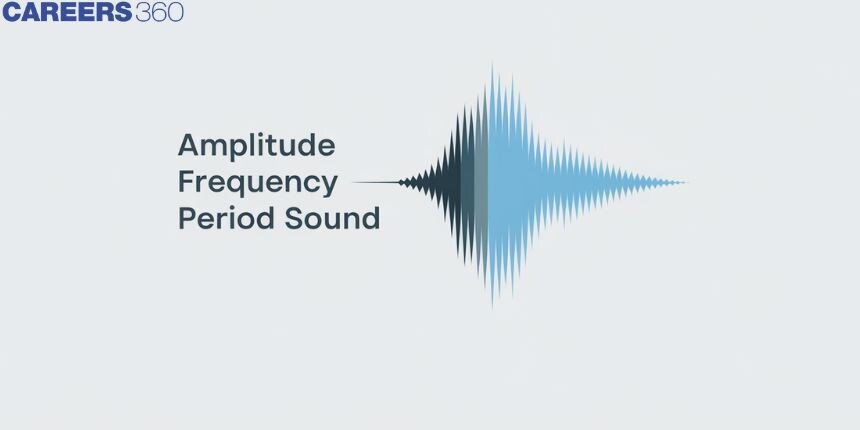Amplitude Frequency Period Sound - Definition, Period, FAQs
Sound waves, like any other wave, have three essential characteristics: amplitude, frequency, and period. The amplitude of sound determines the loudness, while frequency indicates the pitch. The period, or time it takes for one complete cycle of the wave, is inversely related to frequency. These properties are vital in how we perceive sounds, from a soft whisper to the roar of a thunderstorm.
- Amplitude Frequency and Period of Sound
- What is Amplitude?
- What is Amplitude in Sound?
- Oscillation of Sound and Its Properties
- Frequency of Sound
- What is the Period of Sound wave?

In real-world applications, amplitude, frequency, and period define how sound is used in communication, music, and technology. For instance, a high-frequency siren, with a short period, alerts us to emergencies, while variations in amplitude create expressive dynamics in music. Understanding these concepts is crucial in fields like acoustics, audio engineering, and even medical diagnostics, where sound waves aid in imaging through ultrasound.
Amplitude Frequency and Period of Sound
When we sound here every day, we sometimes appreciate it but we get irritated sometimes. Here we're going to know about several sound terminologies. The term amplitude in physics is said to be the largest displacement or distance which moves from an equilibrium position on a body that vibrates or waves. The length of the vibrant path is more or less equal to half. As a result, when a pendulum oscillates from one side to the other, its amplitude is half the distance the bob crosses. The source that vibrates generates waves.
What is Amplitude?
The maximum displacement of an object vibrating from its central position is known as the amplitude of vibration. The amplitude of a wave that is longitudinal in nature, such as a sound wave, is determined by the particle's maximum displacement from its equilibrium location. It's important to note that when a wave's amplitude continually diminishes, it's because its energy is being lost, and the wave is said to be damped.
What is Amplitude in Sound?
The amplitude of sound refers to the maximum displacement of particles in a medium as a sound wave passes through, symbolizing the wave's strength or energy. Greater amplitude results in louder sounds, while lower amplitude produces softer sounds. This is why the amplitude of the sound wave is often discussed in terms of its decibel (dB) measurement, indicating the energy behind the sound wave’s pressure variations. The amplitude diagram typically shows the wave’s height, helping us visualize its energy.
Also read -
- NCERT Solutions for Class 11 Physics
- NCERT Solutions for Class 12 Physics
- NCERT Solutions for All Subjects
Oscillation of Sound and Its Properties
Sound originates from vibrating bodies that create oscillatory motion or rhythmic back-and-forth movement. This process, or oscillation of sound, depends on the medium for transmission. Without a medium, sound cannot propagate, as there would be no particles to carry the vibration. In a sound wave, amplitude directly affects how loud a sound is, while frequency and time period in sound affect its pitch.
Related Topics,
Frequency of Sound
Frequency, measured in hertz (Hz), defines the number of oscillations a sound wave completes per second. A higher frequency means a shorter period, resulting in a higher-pitched sound. The amplitude and frequency together influence the sound’s characteristics and how we perceive its intensity and pitch. The formula $f=\frac{1}{T}$ shows the inverse relationship between frequency and period.
What is the Period of Sound wave?
The period of a sound wave is the time it takes for one complete cycle of the wave to pass a given point. It is the inverse of frequency and is measured in seconds (s). A shorter period corresponds to a higher frequency (higher pitch), while a longer period corresponds to a lower frequency (lower pitch).
Frequently Asked Questions (FAQs)
We can state that these variables have the same basic meaning as the term waves. The term amplitude refers to the distance between the wave's resting position and its highest movement. The number of waves travelling by a certain spot each second is referred to as frequency. The term period refers to the length of time it takes for a wave cycle to finish.
Amplitude is the distance between the medium's equilibrium position and compression, or rarefaction. Starting from zero line amplitude is the name given to the value of the peak of sinusoidal AC signals. The scalar or vector field size is commonly referred to by the term amplitude.
Amplitude is usually expressed in meters.
The formula for determining amplitude is as follows:
x = A sin(ωt+ϕ)
Where,
The displacement in metres is denoted by the letter x.
t is the time in seconds, A is the amplitude in meters, ω is the angular frequency in radians.
The metre [m] is the SI unit of amplitude; however other length units can be used.
Also Read
02 Jul'25 06:19 PM
02 Jul'25 05:07 PM
02 Jul'25 05:04 PM
02 Jul'25 05:00 PM
02 Jul'25 04:59 PM
02 Jul'25 04:53 PM
02 Jul'25 04:48 PM
02 Jul'25 04:47 PM
02 Jul'25 04:45 PM